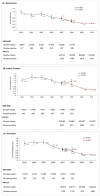Prevention of Parent to Child Transmission (PPTCT) program data in India: an emerging data set for appraising the HIV epidemic
- PMID: 23166595
- PMCID: PMC3499509
- DOI: 10.1371/journal.pone.0048827
Prevention of Parent to Child Transmission (PPTCT) program data in India: an emerging data set for appraising the HIV epidemic
Abstract
Background: Evidence based resource allocation and decentralized planning of an effective HIV/AIDS response requires reliable information on levels and trends of HIV at national and sub-national geographic levels. HIV sentinel surveillance data from antenatal clinics (HSS-ANC) has been an important data source to assess the HIV/AIDS epidemic in India, but has a number of limitations. We assess the value of Prevention of Parent to Child Transmission (PPTCT) programme data to appraise the HIV epidemic in India.
Methods/findings: HIV data from PPTCT sites were compared to HSS-ANC and general population level surveys at various geographic levels in the states of Karnataka, Maharashtra and Andhra Pradesh. Chi-square tests were used to ascertain statistical significance. PPTCT HIV prevalence was significantly lower than HSS-ANC HIV prevalence (0.92% vs. 1.22% in Andhra Pradesh, 0.65% vs. 0.89% in Karnataka, 0.52% vs. 0.60% in Maharashtra, p<0.001 for all three states). In all three states, HIV prevalence from PPTCT centres that were part of the sentinel surveillance was comparable to HSS-ANC prevalence but significantly higher than PPTCT centres that were not part of the sentinel surveillance. HIV prevalence from PPTCT data was comparable to that from general population surveys. In all three states, significant declines in HIV prevalence between 2007 and 2010 were observed with the PPTCT data set. District level analyses of HIV trends and sub-district level analysis of HIV prevalence were possible using the PPTCT and not the HSS-ANC data sets.
Conclusion: HIV prevalence from PPTCT may be a better proxy for general population prevalence than HSS-ANC. PPTCT data allow for analysis of HIV prevalence and trends at smaller geographic units, which is important for decentralized planning of HIV/AIDS programming. With further improvements to the system, India could replace its HSS-ANC with PPTCT programme data for surveillance.
Conflict of interest statement
Figures


Similar articles
-
Comparison of prevention of parent-to-child HIV transmission programme & national biennial HIV sentinel surveillance data for tracking HIV epidemic in India.Indian J Med Res. 2022 Jun;156(6):742-749. doi: 10.4103/ijmr.ijmr_3311_21. Indian J Med Res. 2022. PMID: 37056073 Free PMC article.
-
Can we replace HIV sentinel surveillance platform with prevention of parent-to-child transmission (PPTCT) program data to assess HIV burden and trends in India?Trans R Soc Trop Med Hyg. 2016 Jul;110(7):393-9. doi: 10.1093/trstmh/trw045. Trans R Soc Trop Med Hyg. 2016. PMID: 27496513
-
Utility of Prevention of Parent-to-Child Transmission (PPTCT). Programme data for HIV surveillance in general population.Indian J Med Res. 2010 Sep;132:256-9. Indian J Med Res. 2010. PMID: 20847370
-
HIV prevalence trend from HIV sentinel surveillance over a decade in India: An overview.Indian J Public Health. 2018 Apr-Jun;62(2):138-142. doi: 10.4103/ijph.IJPH_151_16. Indian J Public Health. 2018. PMID: 29923539 Review.
-
[HIV prevalence in sub-Saharan Africa: background of an estimation].Med Sci (Paris). 2009 Jan;25(1):87-92. doi: 10.1051/medsci/200925187. Med Sci (Paris). 2009. PMID: 19154700 Review. French.
Cited by
-
Social representations of mother-to-child transmission of HIV and its prevention in narratives by young Africans from five countries, 1997-2014: Implications for communication.Soc Sci Med. 2018 Aug;211:234-242. doi: 10.1016/j.socscimed.2018.06.006. Epub 2018 Jun 19. Soc Sci Med. 2018. PMID: 29966818 Free PMC article.
-
Monitoring HIV Epidemic in Pregnant Women: Are the Current Measures Enough?J Sex Transm Dis. 2015;2015:194831. doi: 10.1155/2015/194831. Epub 2015 Jan 19. J Sex Transm Dis. 2015. PMID: 26316980 Free PMC article.
-
Comparison of prevention of parent-to-child HIV transmission programme & national biennial HIV sentinel surveillance data for tracking HIV epidemic in India.Indian J Med Res. 2022 Jun;156(6):742-749. doi: 10.4103/ijmr.ijmr_3311_21. Indian J Med Res. 2022. PMID: 37056073 Free PMC article.
References
-
- Bautista-Arredondo S, Gadsden P, Harris JE, Bertozzi SM (2008) Optimizing resource allocation for HIV/AIDS prevention programmes: an analytical framework. Aids 22 Suppl 1S67–74. - PubMed
-
- Wilson D, Halperin DT (2008) “Know your epidemic, know your response”: a useful approach, if we get it right. Lancet 372: 423–426. - PubMed
-
- National AIDS Control Organization (NACO), Ministry of Health and Family Welfare, Government of India (1998) Annual sentinel surveillance for HIV infection - A country report on monitoring of surveillance activities and supervisory visits of HIV infections in the country. New Delhi.
-
- World Health Organization and Joint United Nations Programmes on HIV/AIDS (2011) Guidelines for Second Generation HIV Surveillance: an update: know your epidemic; Geneva. - PubMed
-
- Arora P, Kumar R, Bhattacharya M, Nagelkerke NJ, Jha P (2008) Trends in HIV incidence in India from 2000 to 2007. Lancet 372: 289–290. - PubMed
Publication types
MeSH terms
LinkOut - more resources
Full Text Sources
Medical

